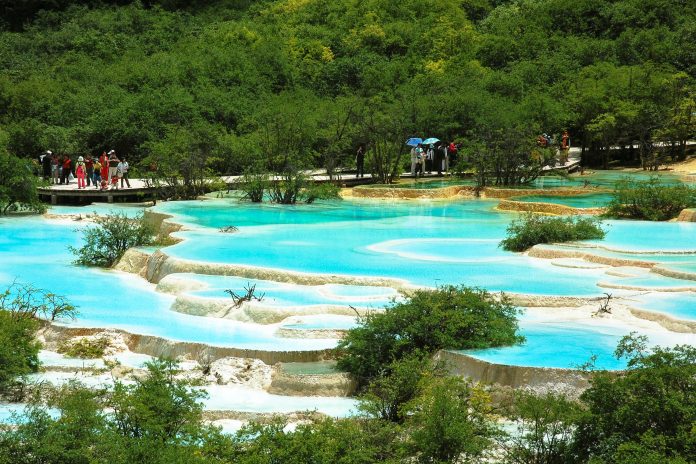Die Kalksinterterrassen im Huanglong-Tal entstanden über die Jahrtausende durch Auswaschungen von Regenwasser und präsentieren sich nun in immens farbenprächtigen Teichen, Quellen, Höhlen und Wasserfällen. Mit der üppigen Vegetation rundherum ist die Schönheit des Tals beinahe kitschig anzusehen.
Huanglong ist ein kleines Örtchen mit etwa 800 Einwohnern im Nordwesten der chinesischen Provinz Sichuan. Der Ort selbst ist touristisch lang nicht so interessant wie seine Umgebung, das knapp 4 Kilometer lange Huanglong-Tal. Die UNESCO nahm die Kalksinterterrassen um Huanglong 1992 auf ihre Liste der Weltnaturerbestätten auf. Auch auf unserer Liste der Top 10 Sehenswürdigkeiten von China ist das wunderschöne Naturschauspiel vertreten.
Teuerste Sehenswürdigkeit Chinas
Das Huanglong-Tal liegt inmitten eines Gebietes aus Sand- und Kalkstein, der über Jahrtausende vom Regenwasser bearbeitet wurde. Im Lauf der Zeit haben sich Kalzit-Terrassen und -Becken gebildet, die in mit kristallklarem Wasser in übernatürlich erscheinenden Gold-, Blau-, Türkis- und Grüntönen gefüllt sind.
Kleine Wasserfälle plätschern über diese Kalksteinterrassen und lassen das gesamte Gebiet in enormer Schönheit erstrahlen. Da sich das Tal einem Drachen gleich durch die schneebedeckten Berggipfel windet, wurde es auch nach ihm benannt: Huanglong heißt übersetzt „Gelber Drache“, gelb durch die Farbe, in der die Sandsteinbecken aus großer Höhe schimmern.
Die Himmel, Wolken, Wälder und Berggipfel rund um das Tal spiegeln sich in den unzähligen Teichen und Quellen und erfüllen jeden Gast mit Staunen über die Kunst der Natur. Nicht umsonst wird das Tal mit Begriffen wie „Weltwunder“ oder „Märchenland“ beschrieben und der Eintritt ist dementsprechend hoch. De facto ist das Huanglong-Tal die teuerste Sehenswürdigkeit in ganz China.
Im Frühjahr wird die atemberaubende Landschaft beinahe kitschig, wenn die blühenden Bäume und Wiesen noch ihren Teil zur Farbenpracht beitragen, die Vögel zwitschern und Schmetterlinge zwischen den Besuchern flattern.
Unterwegs durch die Becken des Huanglong-Tals
Die Kalzitbecken können über Holzstege durchwandert werden, die Wanderung dauert ca. 3-4 Stunden. Den Abschluss des farbenprächtigen Spaziergangs bildet ein buddhistischer Huanglong-Tempel, neben dem sich ebenfalls ein Wasserbecken befindet, dessen schillernde Farbenpracht unübertroffen ist.
Auf dem Weg durch dieses Wunder der Natur bieten sich dem Besucher eine Reihe an Attraktionen. Teiche, Höhlen, Quellen, Wasserfälle, Buddha-Figuren ganz mit Kalksinterkristallen bedeckt und die Huanglong-Tempel. Die bekanntesten sind der Bonsai-Teich, der Spiegel-Teich, der Rododendron-Teich, der Jade-Pflanzen-Teich und der Teich der Blumenwandlung.
Tipp: Die Durchschnittstemperatur im Huanglong-Tal liegt ganzjährig bei ca. 7°C. Am Morgen und Abend liegt die Landschaft aufgrund der hohen Wassermenge oft im Nebel, in der Zeit von Mai bis August kann es regnerisch sein.
Das Huanglong-Tal ist auch für die Religion, Kultur und Folklore wichtig, da sich viele Legenden und Mythen um seine Wasserfälle und Sinterbecken ranken. Dem Xishen-Pubu, dem Wasserfall der Körperreinigung, zum Beispiel werden Heilkräfte nachgesagt, da einst der Gott Xuannu darin badete. Zahlreiche vom Aussterben bedrohte Tiere haben dort noch einen Lebensraum, wie zum Beispiel der Große Panda und der Goldene Stupsnasenaffe.
Auch die Umgebung des Huanglong-Tals ist äußerst sehenswert. Schneebedeckte Berggipfel wechseln sich ab mit jungen Wäldern und gewundenen Tälern, wie zum Beispiel das Muni-Tal. Dort findet man den größten See des Gebiets, den Erdao-See, in den der Zhaga-Wasserfall mündet, der größte Kalk-Wasserfall in ganz China.





